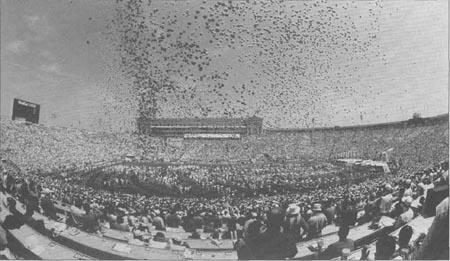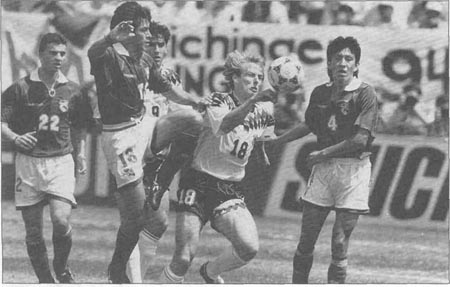Maybe it would have made more sense to convince Ted Turner to let the World Cup call itself the Goodwill Games. That's because goodwill not money was the biggest by-product of the world soccer championship tournament held in Chicago and other cities around the country this summer, city officials say. "We could not have afforded to purchase the advertising coverage that the World Cup took around the world; the international media did a tremendous job for us," said Donna Shaw, director of the Illinois Bureau of Tourism. "It was a once-in-a- lifetime opportunity." Not that this major international sporting event didn't turn a buck. The Chicagoland Chamber of Commerce estimated that the total take by hotels, restaurants, retailing, transportation and other sectors of the local economy came in at $190 million. It's just that everyone was expecting that total to be about $50 million higher. "It fell somewhat under dollar expectations," noted John Skorberg, chief economist at the Chicagoland Chamber. "But it showed Chicago in a very positive light, and it should continue to bring back international visitors for years to come." That kind of goodwill is important, by Skorberg's calculations. For every 10,000 international visitors spending an average of $600 a trip, that's $6 million. State officials didn't have numbers on the actual spending that went into the World Cup ranging from marketing to public service dollars spent on the event. However, published reports placed the city's share of the expense at roughly $3.5 million for infrastructure improvements, police and sanitation. Chicago's handling of the virtually incident-free opening ceremonies and early games led international soccer officials to regret their decision "not to have a quarterfinal match in this city. We felt the fan interest would have supported it," said World Cup spokesman Jim Froslid. Chicago hosted five games in the first and second rounds of the 52-game tournament, and was one of nine cities in the U.S. hosting the event. But fans didn't please everybody. Cab companies voiced frustration that so many of the 300,000 Cup attendees down from an original 400,000-person city estimate chose to make all their downtown commutes to Soldier Field by foot. Ditto for their shopping treks to North Michigan Avenue and Field's on State Street. City hotels took a double whammy an unexpected migration of out-of-town guests to cheaper suburban lodgings at the same time that room commitments promised by the World Cup's organizers fell significantly below their targets. Arnold Karr, executive director of the Illinois Hotel/Motel Association, said that soccer fans created a 4 to 5 percent increase in June hotel business to 77 to 78 percent occupancy, well under the 80 to 85 percent occupancy hoped for by the city's innkeepers during the Cup games held June 17 through July 2. "It wasn't the bonanza we expected, but it turned out fairly well." Paul Astleford, the former Hyatt Corp. and Disney Co. executive brought in to head the city's Convention and Tourism Bureau in April, places some blame for the lower hotel numbers on a less-than-rabid American interest in soccer, but more on the World Cup organizing committee, FIFA. He believes the organizing committee "handled the room arrangements poorly," but the hotel community was able to overcome a potential disaster. He described a meeting two months before the Cup kickoff where world soccer officials allegedly refused to disclose the number of rooms committed. "It was the first time in my career that an organization didn't feel that it was their responsibility to tell us where we stood." So the hotel community had to scramble to commit as many rooms as they could, he said. Tourism's Shaw concurred that local officials were hamstrung by numbers pledged by the World Cup organizers. "We really had no control over those numbers," she said. Froslid, spokesman for the Chicago-based U.S. Soccer Federation and the local World Cup Festivities, understands that local tourism officials were disappointed with the downtown dollars. "This is the first time the U.S. has staged a World Cup. A few things were not projected as accurately as we would have liked." But he added, "The fans did come, and they went to the suburbs because that's where their teams were based, and it was less expensive. In their respective countries, fans typically travel 30, 40, 50 miles to come to the game. They're accustomed to that. They don't have to be a quarter-mile away from (Soldier Field)." Big restaurant winners were spotty, though those with well- placed watering holes in key neighborhoods scored big goals. "The good news is that the out-of-town guests did all their eating and drinking in the hotels. And boy, they did their share of drinking," Karr quipped.
The Illinois Restaurant Association reported that June restaurant sales jumped as much as 20 percent from previous years' figures, thanks not only to the World Cup, but also to major McCormick Place convention events such as the Consumer Electronics Show. Another beneficiary of the World Cup was WCIU-Channel 26 in Chicago, the Spanish-language station that carried the entire tournament. "It was like selling time on a major network," said Peter Zomaya, assistant general manager and general sales manager. "I can't give you exact figures, but the World Cup delivered a 24.8 rating among all Hispanic homes, and we broke all records in the revenue area." Nationally, ABC posted a 9.5 rating for the Italy-Brazil final. The city's premier upscale shopping district, North Michigan Avenue, saw plenty of foot traffic during the Cup, according to Russell Salzman, head of the Greater North Michigan Avenue Association. But the shoppers weren't buying big-ticket items. "What moved were items related to Americana. Nike shoes, blue jeans, T-shirts. The out-of-town guests were on a tourist vacation rather than a Chicago shopping spree. We were pleased with the crowds, but you weren't talking about the kind of shopping traffic you get during the radiologists' convention," said Salzman, indicating that professionals attending conventions in Chicago drop the major bucks at downtown stores. But so what if the overall tourism numbers were disappointing? City and convention officials say they'll settle for the positive publicity sunny lakefront images beamed around the world can bring. "If we had not generated one international visitor, this would have been a smashing success," said Astleford, explaining that broadcast pictures of the Cup's opening ceremonies at Soldier Field were invaluable to the city. "The night after the opener, I got a call from a (world soccer) official in Milan. She was watching (Italian TV) and said they were beaming a panoramic view of Chicago's lakefront, and said, 'You could not have made a better advertisement for the city of Chicago.'" It sure beats the gangster image that Chicago still struggles to shake, Astleford adds. "Being the realist that I am, I have to recognize that the one billion people viewing the events around the world were interested in the soccer games themselves, not the city. But there's lasting value in that the World Cup committee had chosen the city of Chicago, one that few people internationally know anything about, for a tournament site. And that will be a lasting image for one billion people." U.S. soccer organizers are hoping the World Cup provides enough momentum for next spring's launch of Major League Soccer, a new nationwide professional soccer league. Seven of 12 cities including New York, Washington and Los Angeles have been selected for franchises, and Chicago may be one of the remaining ones to be announced by October, Froslid said. That's why World Cup memories will be so important.
September 1994/lllinois Issues/21
Finally getting to bury Capone is one advantage of the whole world watching, but Chicago has another image cleanup project waiting in the wings: the 1996 Democratic convention. Most tourism experts believe the ugly TV images of the 1968 Democratic convention in Chicago, including riots and clashes with police, will be considered part of history, of the past, of nostalgia. The '96 convention will be much more sedate. Though convention events will take place at the new United Center, the McCormick Place expansion will be open by then to continue private-sector convention business through the national party's coronation ceremonies, Skorberg points out. "The good press we received from the World Cup, I think, helped seal things with the Democrats," Karr believes. Some 17,300 of the downtown area's 26,000 hotel rooms are already committed. "That was really excellent news." Salzman agrees, saying that storekeepers will be waiting for the summer of 1996. "The strength of the World Cup PR effort is good, because it showed on a world scale Chicago's ability to handle major international events. "And that will serve us well when the Democrats come to town." Lisa Holton is special sections editor at the Chicago Sun-Times.
"The best thing that came out of the World Cup is that the people who came were absolutely astounded with what they found The former Disney Company executive believes that reality not only has to match the image, but it has to surpass the image. "Disney's biggest job is to live up to the marketing image they've created. You hear Disney World is clean and the people are nice, but you are surprised when you get there how clean and how nice it is. That's what has to happen here." Astleford says the World Cup has helped the agency's efforts to develop a new strategic long-term marketing plan for Chicago. "There's never been a long-term master plan for the branding, logoing and imaging of this city, all of which has to be well- researched. This has to be done through a very deliberate marketing process so we know what we're going to be doing one year from now, five years from now and 10 years from now." And where will the extra dollars come from? Astleford claims that he won't need much more money just "a lot of labor time. It can be done reasonably in terms of cost. The funds are the secondary issue. The real issue is what the plan is." He expects to present such a plan to Mayor Daley by next spring. Lisa Holton 22/September 1994/Illinois Issues
|
|||||||||||||||

